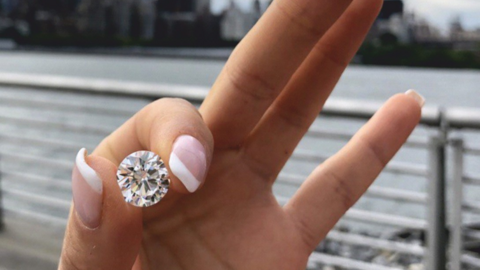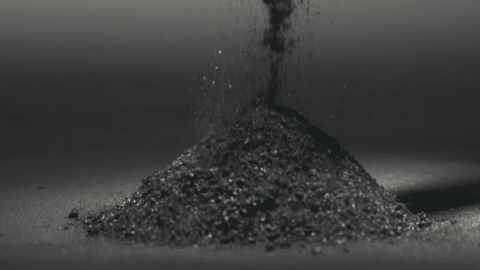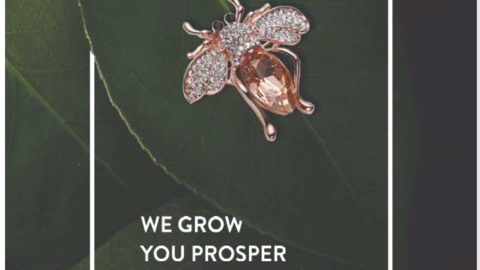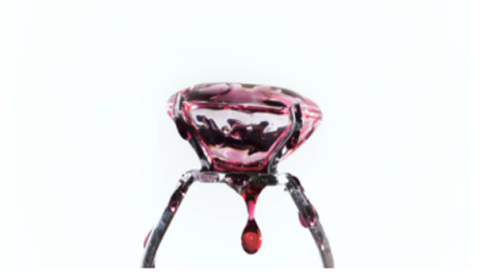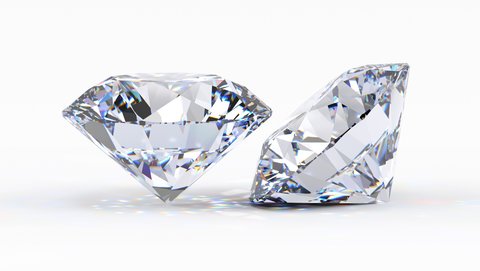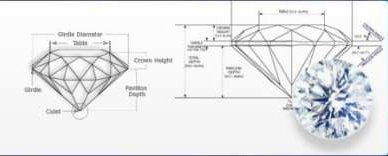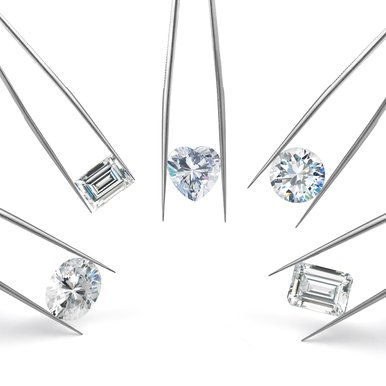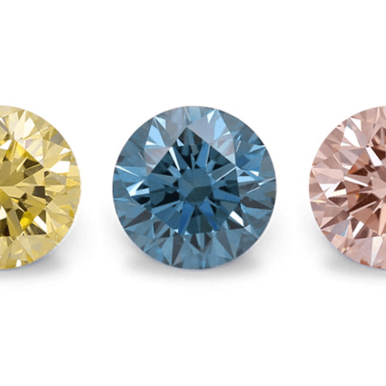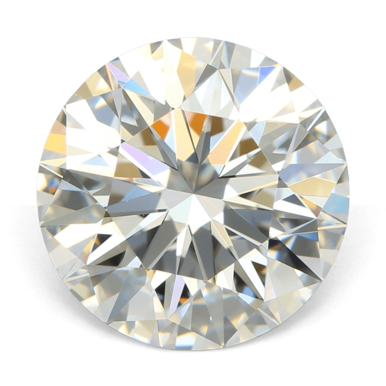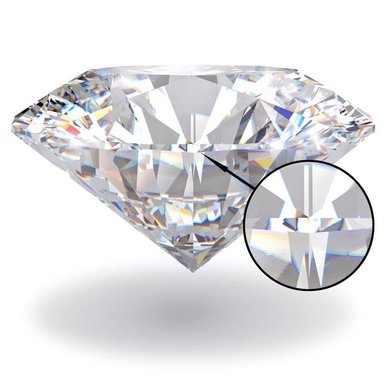The Elegant Choice: Comparing Pear and Oval Cut Lab-Grown Diamonds

In the world of precious gems, diamonds have always held a special place in our hearts and jewelry collections. When considering a lab-grown diamond for that special occasion or statement piece, the cut you choose dramatically impacts both the stone's brilliance and how it complements your style. Among the most captivating options are pear and oval cut diamonds, each offering unique characteristics that appeal to different preferences.
At Labrilliante, we've created this comprehensive guide to help you navigate the distinctive features of pear and oval cut lab-grown diamonds, ensuring you make a choice that perfectly reflects your personal style and practical needs.
The Diamond Foundation: Understanding Cut Basics
When evaluating diamonds, experts refer to the renowned 4Cs—Cut, Color, Clarity, and Carat—which serve as the universal standard for determining a diamond's quality and value. Among these characteristics, cut stands as perhaps the most influential factor in a diamond's overall brilliance and fire.
It's important to distinguish between diamond shape and diamond cut. While shape refers to the geometric outline (such as pear or oval), cut specifically describes how well the diamond's facets interact with light. A properly cut diamond, regardless of shape, will maximize light return through three crucial optical effects: brilliance (white light reflected from the diamond), fire (colored light dispersion), and scintillation (the sparkle when the diamond moves).
Lab-grown diamonds, which Labrilliante specializes in, offer these same stunning optical properties as mined diamonds but are created in controlled laboratory environments that replicate natural diamond-forming conditions. These ethical alternatives feature identical chemical, physical, and optical properties to mined diamonds, allowing for the same beautiful cuts without environmental concerns.
Popular Diamond Cuts at a Glance
| Cut Type | Facet Count | Origin | Light Performance | Popularity Rank |
|---|---|---|---|---|
| Round Brilliant | 57-58 | 1900s | Exceptional | #1 |
| Princess | 57-76 | 1980s | Very Good | #2 |
| Oval | 57 | 1960s | Excellent | #3 |
| Pear | 58 | 1400s | Excellent | #4 |
| Emerald | 57 | Early 1900s | Good (different type) | #5 |
| Cushion | 58-64 | 1800s | Very Good | #6 |

Oval Cut Diamonds: Timeless Elegance in Innovation
The oval cut diamond, though relatively modern in the diamond world, has quickly risen to prominence since its development by master cutter Lazare Kaplan in the 1960s. This innovative shape combines the brilliance of the round cut with a distinctive elongated form, making it a sophisticated choice for those seeking both sparkle and uniqueness.
Technical Brilliance by Design
Oval diamonds typically feature 57 facets—the same number as round brilliants—arranged in a modified brilliant cut pattern. This strategic faceting creates exceptional light performance while offering a distinctive silhouette. At Labrilliante, our master cutters pay careful attention to proportion, particularly the critical length-to-width ratio which ideally falls between 1.35 and 1.50. This optimal range ensures the diamond appears neither too narrow nor too wide, maintaining visual harmony while maximizing brilliance.
The Celebrity Choice
Oval diamonds have gained tremendous popularity in recent years, adorning the fingers of numerous celebrities and influencers. Their elongated shape creates a slimming effect on the hand and finger, making them particularly flattering when worn. This shape also has the advantage of appearing larger than round diamonds of equal carat weight due to their expanded surface area—a practical benefit many Labrilliante customers appreciate.
Setting Trends with Timeless Appeal
While contemporary in popularity, oval diamonds possess a timeless quality that transcends passing trends. Their smooth curves and brilliant faceting create a versatile gem that works beautifully in both modern minimalist settings and ornate vintage-inspired designs. At Labrilliante, we've seen growing demand for oval lab-grown diamonds, particularly among customers who appreciate their elegant silhouette and abundant sparkle.

Pear Cut Diamonds: The Teardrop of Timeless Sophistication
The pear cut diamond, also known as the "teardrop" diamond, boasts an illustrious history dating back to the 15th century when pioneering diamond cutter Lodewyk van Bercken first introduced this magnificent shape. This innovative blend of a round brilliant on one end and a marquise point on the other creates a distinctive silhouette that has enchanted diamond enthusiasts for centuries.
A Historical Masterpiece of Engineering
Pear cut diamonds represent a remarkable fusion of cutting techniques, typically featuring 58 facets arranged to maximize both brilliance and the unique teardrop silhouette. At Labrilliante, our master cutters focus meticulously on achieving the ideal length-to-width ratio of 1.45-1.75, ensuring each pear diamond maintains perfect proportions and optimal light performance. This careful calibration prevents the diamond from appearing either too narrow or too stubby, preserving its elegant form.
Symbolism and Sentiment
Beyond their striking appearance, pear diamonds carry rich symbolism that enhances their appeal. The teardrop shape has historically represented tears of joy or emotional transformation, making these diamonds particularly meaningful for significant life milestones. Their distinctive asymmetry also symbolizes confidence and individuality, resonating with those who appreciate standing out from the crowd.
Celebrity Heritage
The pear cut diamond's prestigious legacy includes some of history's most famous gems. Perhaps most notably, Elizabeth Taylor once owned the remarkable 69.42-carat pear-shaped diamond that captivated the public imagination. Today, numerous celebrities and style icons continue to choose pear-shaped diamonds for their engagement rings and statement jewelry, cementing this cut's status as both historically significant and contemporarily fashionable.
Side-by-Side: The Visual Symphony of Pear vs. Oval
When choosing between pear and oval cut diamonds, understanding their visual differences is essential for finding the perfect match for your style. While both cuts share certain qualities that make them popular alternatives to the traditional round brilliant, their distinctive characteristics create notably different aesthetic effects.
Symmetry: The Visual Balance
The most immediately apparent difference between these cuts lies in their symmetry. Oval diamonds feature perfect bilateral symmetry, creating a balanced, harmonious appearance from every angle. This symmetry offers a classic, sophisticated look that works beautifully in a wide range of settings.
Pear diamonds, conversely, showcase intentional asymmetry with their rounded end tapering to a single point. This distinctive silhouette creates visual interest and a unique directional flow that many Labrilliante customers find captivating. The asymmetry makes pear diamonds particularly striking when used as center stones, drawing the eye along their graceful curve.
Finger Flattery: How Each Cut Wears
Both pear and oval cuts offer significant advantages when worn on the hand:
Finger Appearance Comparison: Oval vs. Pear
| Feature | Oval Effect | Pear Effect |
|---|---|---|
| Finger Appearance | Creates elongating illusion | Creates elongating illusion with directional emphasis |
| Hand Flattery | Slims and lengthens fingers | Slims fingers with pointed direction |
| Ring Placement | Centered, balanced look | Usually worn with point toward fingertips |
| Visual Size | Appears 10-15% larger than round of same carat | Appears 10-15% larger than round of same carat |
| Movement Effect | Consistent sparkle pattern | Varied sparkle pattern from round to pointed end |
Size Perception: The Carat Advantage
Both cuts benefit from what gemologists call the "spread effect"—they appear larger than round diamonds of the same carat weight due to their elongated shape. At Labrilliante, our customers are often pleasantly surprised by how impressive both pear and oval cuts appear when compared to round brilliants of equal weight.
However, there are subtle differences in size perception:
- Oval diamonds present a more evenly distributed surface area
- Pear diamonds concentrate visual weight toward their rounded end, with the point creating a directional emphasis
Style Spectrum: Modern vs. Vintage Appeal
The aesthetic character of each cut appeals to different style sensibilities.
Oval diamonds tend to project a clean, contemporary elegance that pairs beautifully with modern minimalist settings. Their smooth, continuous curve aligns perfectly with current trends in streamlined design.
Pear diamonds often evoke a more romantic, vintage-inspired aesthetic, though they've experienced a modern renaissance in recent years. At Labrilliante, we regularly create contemporary interpretations of this historically rich cut that balance its classic appeal with fresh, innovative settings.

Style Spectrum: Modern vs. Vintage Appeal
The aesthetic character of each cut appeals to different style sensibilities:
Oval diamonds tend to project a clean, contemporary elegance that pairs beautifully with modern minimalist settings. Their smooth, continuous curve aligns perfectly with current trends in streamlined design.
Pear diamonds often evoke a more romantic, vintage-inspired aesthetic, though they've experienced a modern renaissance in recent years. At Labrilliante, we regularly create contemporary interpretations of this historically rich cut that balance its classic appeal with fresh, innovative settings.
Quality Matters: Navigating Cut Defects and Excellence
Both oval and pear cut diamonds present unique quality considerations that informed buyers should understand before making their selection. While these cuts offer exceptional beauty when executed properly, they're also susceptible to specific optical phenomena and cutting challenges that can impact their appearance.
The Bowtie Effect: Understanding the Shadow
One of the most notable considerations in both oval and pear cut diamonds is the "bowtie effect"—a dark shadow that appears across the center of the stone, resembling a bowtie. This optical effect occurs due to the elongated shape and facet arrangement of these cuts, causing some light to escape rather than return to the viewer's eye.
Bowtie Severity Comparison
| Bowtie Severity | Visual Impact | Desirability | Price Impact |
|---|---|---|---|
| None/Minimal | Even brilliance throughout | Highest | Premium pricing |
| Light | Subtle shadow visible in specific lighting | Very good | Slight premium |
| Moderate | Noticeable shadow in most lighting | Acceptable | Standard pricing |
| Pronounced | Prominent dark area dominating appearance | Lower | Discounted pricing |
At Labrilliante, our expert cutters carefully optimize each diamond's proportions to minimize this effect, though it's important to understand that some degree of bowtie is inherent to these shapes. The goal is to balance the cut to ensure the bowtie doesn't detract from the diamond's overall brilliance and fire.
Cut-Specific Quality Concerns
Oval Diamond Quality Factors
- Symmetry challenges: Uneven curves can create an imbalanced appearance
- Irregular bowtie: Poor cutting can produce an asymmetrical or overly pronounced bowtie
- "Squatty" or "stretched" proportions: Ratios outside the ideal 1.35-1.50 range can appear disproportionate
- Uneven faceting: Can create dead spots where brilliance is diminished
Pear Diamond Quality Factors
- Uneven shoulders: The curved end should have symmetrical sides
- Vulnerable pointed tip: Susceptible to chipping if not properly protected by settings
- Bow-tie positioning: Should be centered and proportional
- "Flat" or "bulbous" outlines: Extreme proportions outside the 1.45-1.75 ratio range
- Irregular point: Should be centered and properly aligned with the diamond's axis
Evaluating Quality When Purchasing
When shopping for lab-grown pear or oval diamonds at Labrilliante, we recommend the following quality evaluation approach:
- Request videos in various lighting: This reveals how the bowtie appears under different conditions
- Check certification details: Look for "Excellent" or "Very Good" symmetry ratings
- Examine from multiple angles: Assess brilliance consistency across the stone
- Verify ideal proportions: Confirm the diamond falls within recommended ratio ranges
- Inspect setting protection: Particularly for pear diamonds, ensure the pointed tip is secured
Investment Comparison: Pricing and Value Between Cuts
When selecting between pear and oval cut lab-grown diamonds, understanding their relative cost factors helps ensure you receive maximum value for your investment. While both cuts offer excellent alternatives to the premium-priced round brilliant, several factors influence their comparative pricing.
General Price Positioning
Lab-grown diamonds generally represent a value advantage over mined diamonds, regardless of cut. At Labrilliante, our sustainable lab-grown diamonds typically cost 30-40% less than their mined counterparts of equivalent quality, allowing you to maximize your budget without compromise.
When comparing cuts specifically, both pear and oval diamonds typically fall into a similar price range. However, subtle differences exist based on current market demand and production factors:
Diamond Cut Price Comparison
| Cut Type | Price Relative to Round Brilliant | Main Price Factors | Current Demand |
|---|---|---|---|
| Oval | 15-25% less | Popularity, symmetry requirements | Very High |
| Pear | 15-30% less | Complexity, tip vulnerability | High |
| Round | Benchmark (highest) | Maximum rough diamond waste | Highest |
| Princess | 25-35% less | Efficient use of rough | Moderate |
Size Perception Value
One significant advantage of both pear and oval cuts is their favorable size appearance relative to their carat weight. Both cuts typically appear 10-15% larger than round diamonds of equal weight due to their larger face-up surface area. This "spread advantage" delivers excellent value, giving you a visually larger diamond for the same price.
Quality Factors Affecting Price
Several quality considerations particularly impact pricing in these elongated cuts:
- Bowtie Severity: Diamonds with minimal bowtie effect command premium prices
- Ideal Proportions: Stones with perfect length-to-width ratios sell at a premium
- Symmetry Grade: Excellent symmetry impacts price more significantly in these cuts
- Point Perfection: For pear cuts, precise point formation affects valuation
Price Range Examples
For context, here are approximate price ranges for lab-grown pear and oval diamonds available at Labrilliante:
Lab-Grown Diamond Price Ranges
| Quality Tier | 1 Carat Oval | 1 Carat Pear | 1.5 Carat Oval | 1.5 Carat Pear |
|---|---|---|---|---|
| Premium (VS1-VS2, F-G) | $1,800-2,200 | $1,750-2,150 | $2,800-3,400 | $2,700-3,300 |
| Mid-Range (SI1, G-H) | $1,500-1,800 | $1,450-1,750 | $2,300-2,800 | $2,200-2,700 |
| Value (SI2, H-I) | $1,200-1,500 | $1,150-1,450 | $1,900-2,300 | $1,850-2,200 |
Setting the Stage: Best Mounts for Pear and Oval Diamonds
The perfect setting enhances a diamond's natural beauty while providing necessary protection and complementing your personal style. Both pear and oval cut lab-grown diamonds offer versatile possibilities for stunning jewelry applications, though each shape has specific setting considerations that optimize their unique characteristics.
Ideal Settings for Oval Cut Diamonds
Oval diamonds pair beautifully with various setting styles, each highlighting different aspects of the cut's elegant form:
Prong Settings
The classic prong setting remains among the most popular choices for oval diamonds. A four or six-prong configuration effectively secures the stone while maximizing light exposure. At Labrilliante, we typically recommend:
- Four prongs at the corners for a sleek, minimalist look
- Six prongs for larger stones requiring additional security
Halo Settings
Oval diamonds truly shine in halo settings, where a ring of smaller diamonds surrounds the center stone. This setting style:
- Enhances the apparent size of the center diamond
- Minimizes the visibility of any bowtie effect
- Creates a dazzling frame that complements the oval's smooth curves
Bezel Settings
For those with active lifestyles, the protective bezel setting offers an elegant solution:
- Metal rim completely surrounds the diamond's edge
- Provides maximum protection against damage
- Creates a smooth, contemporary profile
Three-Stone Settings
Oval diamonds serve as stunning center stones in three-stone designs:
- Flanking diamonds (often round or pear) create balanced composition
- Emphasizes the oval's elongated elegance
- Allows for creative mixed-shape arrangements
Protective Settings for Pear Cut Diamonds
Pear diamonds require special setting consideration due to their pointed tip, which needs proper protection:
V-Prong Settings
The specialized V-prong (or claw) setting is designed specifically for pear diamonds:
- V-shaped prong cradles and protects the vulnerable tip
- Additional prongs secure the rounded end
- Provides excellent protection while maximizing light exposure
Semi-Bezel Settings
This hybrid setting style offers excellent protection with visual lightness:
- Partial metal rim around the sides and tip
- Leaves portions of the diamond edge exposed for light entry
- Creates a modern, sculptural appearance
Pendant Settings
Pear diamonds excel as pendant centerpieces:
- Typically hung with the point facing downward
- Creates a natural teardrop appearance
- Often set with a decorative bail that protects the top edge
Metal Pairing Recommendations
The choice of metal significantly impacts the final appearance of your jewelry:
Metal Pairing Recommendations for Diamond Cuts
| Metal Type | Best Diamond Color Grade | Effect with Oval | Effect with Pear |
|---|---|---|---|
| Platinum | All colors, ideal for D-F | Modern, sleek contrast | Sophisticated, clean lines |
| White Gold | F+ | Bright, contemporary look | Crisp, defined edges |
| Yellow Gold | G+ | Warm contrast, vintage feel | Romantic, classic appearance |
| Rose Gold | H+ | Soft, feminine aesthetic | Romantic, distinctive edge |

Beyond Engagement Rings: Versatile Applications
While engagement rings remain the most popular application, both cuts offer versatility across jewelry types:
Earrings
- Oval: Elegant studs or sophisticated drops
- Pear: Classic drops with points facing either down or inward
Necklaces
- Oval: Horizontal or vertical orientation as solitaire pendants
- Pear: Natural teardrop pendants or creative multi-stone arrangements
Bracelets
- Oval: Tennis bracelets or featured center stones
- Pear: Directional accent stones in luxury bracelets
At Labrilliante, our jewelry designers specialize in creating bespoke settings that maximize the beauty of our lab-grown diamonds while ensuring durability for everyday wear.

Finding Your Perfect Match: Choosing Between Pear and Oval
Selecting the ideal diamond cut is ultimately a personal decision that should reflect your individual style, lifestyle needs, and the symbolic meaning you wish to convey. At Labrilliante, we believe that understanding the practical and aesthetic considerations of each cut helps our clients make confident, informed choices they'll cherish for years to come.
Lifestyle Considerations
Your daily activities and lifestyle should influence your diamond selection:
Lifestyle Considerations for Diamond Cut Selection
| Lifestyle Factor | Oval Advantage | Pear Advantage | Recommendation |
|---|---|---|---|
| Very Active | Smooth profile with no points | Vulnerable tip even in protective settings | Oval in bezel setting |
| Occasional Wear | Either cut works well | Either cut works well | Either cut in preferred setting |
| Professional Environment | Classic, versatile appearance | More distinctive, fashion-forward | Oval for traditional, Pear for creative fields |
| Frequent Hand Use | Lower profile settings recommended | V-prong or protective settings essential | Either with appropriate protection |
Personal Style Matching
Your fashion preferences and aesthetic sensibilities naturally align with certain diamond characteristics:
Finding Your Perfect Match: Choosing Between Pear and Oval
Modern Minimalist
If your style embraces clean lines, contemporary design, and understated elegance:
- Oval diamonds in simple solitaire or bezel settings
- Sleek metal choices like platinum or white gold
- Emphasis on excellent proportions rather than maximum sparkle
Vintage Romantic
If you're drawn to nostalgic, detailed, and ornate aesthetics:
- Pear diamonds in decorative settings with milgrain details
- Rose or yellow gold for warmth and period authenticity
- Consider pairing with smaller accent stones
Bold Statement Maker
If you prefer distinctive, conversation-starting pieces:
- Larger pear diamonds with dramatic length-to-width ratios
- East-west (horizontal) settings for either cut
- Consider unique metal combinations or colored lab-grown diamonds
Classic Traditionalist
If you appreciate timeless, enduring designs:
- Oval diamonds in classic settings like solitaire or three-stone
- Traditional metals like platinum or white gold
- Emphasis on exceptional clarity and color
Symbolism and Meaning
Diamond shapes carry subtle emotional and symbolic associations:
- Oval Diamonds represent harmony, continuity, and eternal bonds—making them meaningful choices for engagements and anniversaries
- Pear Diamonds symbolize tears of joy, emotional transformation, and uniqueness—perfect for marking significant life changes or expressing individuality
Practical Decision Framework
At Labrilliante, we suggest considering these five key factors when making your final decision:
- Visual Appeal: Which shape simply speaks to you on an emotional level?
- Finger Flattery: Which shape looks most complementary on your hand?
- Setting Preference: Do you have a specific setting style in mind?
- Protection Needs: How important is durability in your daily life?
- Stand Out vs. Blend In: Do you prefer distinctive or classic jewelry?
Ethical Brilliance: Lab-Grown Diamonds for Conscious Luxury
As a pioneer in lab-grown diamonds, Labrilliante takes pride in offering environmentally and socially responsible alternatives to mined diamonds. When comparing pear and oval cuts, understanding the specific advantages of choosing lab-grown options can help inform your decision.
Availability Comparison in Lab-Grown Diamonds
Both pear and oval cuts are readily available in the lab-grown diamond market, with some notable differences:
Lab-Grown Diamond Availability by Cut
| Aspect | Oval Lab-Grown | Pear Lab-Grown |
|---|---|---|
| Size Range | Excellent availability from 0.5-5+ carats | Excellent availability from 0.5-3+ carats |
| Color Range | Full range (D-K) | Full range (D-K) |
| Clarity Range | All clarity grades available | All clarity grades available |
| Fancy Colors | Growing selection, especially blues and pinks | Growing selection, especially yellows and pinks |
| Custom Options | Highly customizable proportions | Highly customizable proportions |
At Labrilliante, we maintain an extensive inventory of both cuts, allowing clients to choose from a wide selection of lab-grown diamonds with exceptional quality characteristics.
Price Advantage of Lab-Grown Options
Lab-grown diamonds offer significant cost benefits compared to their mined counterparts.
On average, Labrilliante lab-grown pear and oval diamonds cost 30-40% less than comparable mined diamonds, allowing you to:
- Choose a larger carat weight within the same budget
- Opt for higher color and clarity grades
- Invest in a more elaborate setting
- Consider fancy colored diamonds that would be prohibitively expensive in mined options
Quality Considerations
Modern lab-grown diamonds are indistinguishable from mined diamonds in terms of:
- Chemical composition (100% carbon in crystalline structure)
- Physical properties (identical hardness, refractive index)
- Optical brilliance and fire
- Durability and longevity
Our advanced growing techniques allow for exceptional clarity in lab-grown diamonds, often resulting in fewer inclusions than typically found in naturally formed stones.
Certification and Grading
At Labrilliante, all our lab-grown diamonds receive the same rigorous certification as mined diamonds:
- Independent grading by renowned gemological laboratories
- Full documentation of the 4Cs (cut, color, clarity, carat)
- Laser inscription identifying the diamond as lab-grown
- Comprehensive grading reports with each purchase
Ethical and Environmental Advantages
Choosing a lab-grown diamond from Labrilliante offers peace of mind through:
- Minimal environmental impact compared to mining operations
- Zero connection to conflict diamonds or exploitative labor practices
- Reduced carbon footprint (our facilities use renewable energy)
- Complete transparency in the supply chain
- Perfect alignment with modern values of sustainability and responsibility
Finding Excellence: Your Guide to Purchasing Exceptional Diamonds
Making an informed diamond purchase requires not only understanding the characteristics of different cuts but also knowing where to find quality stones at fair prices. As a premier provider of lab-grown diamonds, Labrilliante offers exceptional value and selection for those seeking pear and oval cut diamonds.
What Sets Labrilliante Apart
When searching for the perfect diamond, it's essential to choose a retailer with proven expertise and ethical standards:
- Expert Craftsmanship: Our master cutters specialize in precision-cutting techniques that minimize unwanted optical effects in both pear and oval diamonds
- Advanced Technology: We utilize state-of-the-art growing methods to produce diamonds with exceptional clarity and color consistency
- Transparent Process: Every Labrilliante diamond comes with comprehensive documentation and certification
- Sustainable Practices: Our lab-grown diamonds are created using renewable energy and environmentally responsible processes
- Customization Options: We offer bespoke cutting services to achieve your desired proportions and specifications
Essential Questions to Ask When Shopping
Before making your purchase, be prepared to ask these critical questions:
- Certification Details: Is the diamond certified by a reputable laboratory?
- Proportion Specifics: What is the exact length-to-width ratio of the diamond?
- Bowtie Assessment: Can you provide videos showing the diamond in different lighting to assess bowtie severity?
- Setting Recommendations: What setting styles do you recommend for this specific diamond?
- Upgrade Policies: Do you offer trade-up options if I wish to increase size later?
Price Expectations and Value Indicators
Understanding typical price ranges helps you recognize exceptional value:
Lab-Grown Diamond Price Expectations
| Diamond Type | Entry Level | Mid-Range | Premium |
|---|---|---|---|
| 1ct Oval Lab-Grown (H, VS2) | $1,200-1,500 | $1,500-2,000 | $2,000-2,500 |
| 1ct Pear Lab-Grown (H, VS2) | $1,150-1,450 | $1,450-1,950 | $1,950-2,450 |
| 2ct Oval Lab-Grown (H, VS2) | $3,000-3,800 | $3,800-4,500 | $4,500-5,500 |
| 2ct Pear Lab-Grown (H, VS2) | $2,900-3,700 | $3,700-4,400 | $4,400-5,400 |
Return Policies Worth Considering
When making such a significant purchase, understanding return options provides peace of mind:
- Labrilliante offers a 30-day inspection period for all diamond purchases
- Free return shipping on all orders
- Complimentary resizing for rings within 90 days
- Lifetime warranty against manufacturing defects
- Future upgrade options with favorable trade-in values

The Labrilliante Experience
From initial consultation to final delivery, we provide a comprehensive service experience:
- Educational Consultation: Our gemologists help you understand the specific characteristics of different diamond cuts
- Visual Comparison: View multiple diamonds side-by-side to appreciate subtle differences
- Custom Design: Work with our designers to create the perfect setting for your chosen diamond
- Ethical Assurance: Receive complete documentation of your diamond's origins and specifications
- Lifetime Support: Enjoy ongoing cleaning, inspection, and maintenance services
Making Your Diamond Decision with Confidence
Choosing between pear and oval cut lab-grown diamonds ultimately comes down to your personal aesthetic preferences, lifestyle considerations, and the statement you wish to make with your jewelry. Both cuts offer distinct advantages that appeal to different sensibilities while providing excellent alternatives to traditional round brilliants.
Key Differences at a Glance
Pear vs. Oval Cut: Key Differences Summary
| Feature | Oval Cut | Pear Cut |
|---|---|---|
| Shape Characteristics | Symmetrical, balanced, elongated | Asymmetrical, teardrop, directional |
| Historical Context | Modern (1960s) | Historical (1400s) |
| Symbolic Meaning | Harmony, continuity | Transformation, individuality |
| Best Settings | Versatile across most setting styles | V-prong and protective settings recommended |
| Ideal For | Classic elegance, versatile wear | Distinctive statement, vintage appeal |
| Finger Effect | Elongating, balanced | Elongating, directional |

Your Personal Diamond Journey
At Labrilliante, we believe that selecting the perfect diamond should be an enjoyable, educational experience. Our expert gemologists are dedicated to guiding you through every step of the process, from understanding cut characteristics to choosing the ideal setting for your lifestyle.
Our lab-grown diamonds offer the same exceptional beauty and durability as mined diamonds, with the added benefits of ethical sourcing, environmental responsibility, and excellent value. Whether you're drawn to the symmetrical elegance of an oval cut or the distinctive character of a pear cut, you'll find exceptional options in our curated collection.
We invite you to explore our collection online to experience these remarkable diamond cuts. With Labrilliante's guidance, your perfect diamond is waiting to become part of your story.
Ready for Your Diamond Journey?
Contact Labrilliante today to schedule a personalized consultation with our diamond experts, who can help you navigate the exciting world of lab-grown pear and oval diamonds.
Other diamond shapes
Frequently Asked Questions About Pear and Oval Diamonds
While both cuts enjoy significant popularity, oval cut diamonds have seen a substantial surge in recent years, particularly for engagement rings. However, pear cut diamonds maintain a strong following among those seeking distinctive, eye-catching designs with historical significance.
Both cuts typically appear 10-15% larger than round diamonds of equal weight. Between the two, the apparent size depends largely on proportions rather than shape alone, though some find that pear diamonds with ideal length-to-width ratios can create a slightly larger appearance due to their tapered point.
Traditionally, pear engagement rings are worn with the point facing away from the body (toward the fingertips), creating a slimming effect on the finger. However, some contemporary designs feature east-west (horizontal) orientation or even point-toward-hand positioning for a unique look.
Both cuts balance trendy appeal with timeless elegance. Oval diamonds lean more toward classic versatility, while pear cuts, despite centuries of history, make more distinctive statements that can appear either vintage or cutting-edge depending on the setting.
Yes, both cuts tend to show slightly more color than round brilliants, particularly at the pointed end of pear diamonds. At Labrilliante, we recommend choosing color grades F or higher for white gold or platinum settings, and H or higher for yellow or rose gold settings.
Selecting a diamond with optimal proportions is the primary method for minimizing the bowtie effect. At Labrilliante, we carefully assess each diamond's cut quality and only offer stones with minimal to moderate bowtie visibility. Certain settings, particularly those with halos or accent stones, can also help distract from any visible bowtie.
Oval diamonds generally offer excellent durability with no vulnerable points. Pear diamonds require additional protection for their pointed tip, making setting choice particularly important. With proper setting selection, both cuts can provide generations of wear.
Both cuts can be cleaned using the same methods: warm water with mild dish soap, gentle brushing with a soft toothbrush, and careful rinsing. For pear cuts, take extra care around the pointed tip during cleaning. Professional cleaning twice yearly is recommended for both cuts.


